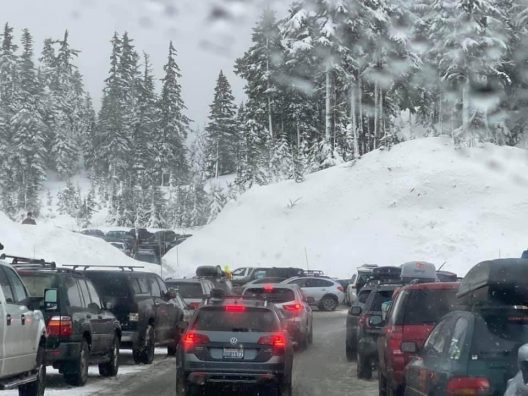If you’ve hit the trails or the water this year, you know COVID-19 has transformed the way many people are recreating in our wild spaces. Places that were previously “off the beaten track” are as popular as they’ve ever been, and the usual hotspots are overwhelmed with hikers, campers and skiers. What does this mean for our wild spaces, and how can we be better stewards?

This year’s biggest disruption, the coronavirus, is what has driven this new demand. Public health officials are recommending outdoor activities based on science that shows people are almost 20 times more likely to catch COVID-19 indoors than outside. Without the ability to gather at bars, museums or restaurants, the outdoors is what’s left.
Research in environmental psychology aims to understand the phenomenon. “It has been observed in all sorts of situations of risk, stress or disaster, that people turn to nature for solace and healing experiences – scientists call this ‘urgent biophilia.’” says Kathleen Wolf, research scientist in the UW School of Environmental and Forest Sciences. “In addition to achieving social distancing, people may be intuitively recognizing the restorative qualities of nature.“
The surge in outdoor recreation is unprecedented, which land stewards say is bittersweet. Many organizations promote the use of wildlands, and decades of studies have proven the physical and mental benefits of being outdoors. Both natural and social conditions can take a step backwards when there is overuse and abuse of recreation sites, or large congregations and poor social distancing.
Frustration and outrage surrounds many popular sites near Seattle. On a single August weekend day, rangers on the Colchuck Lake trail counted almost a thousand hikers and buried 200 piles of human waste. Anecdotes on social media suggest people have been stopped for hours to get past blocked travel lanes on highways at Staircase on the Olympic Peninsula and Highway 2 near Eagle Falls. The blockages are often due to inexperienced recreationists parking in illegal areas or crossing busy highways while carrying mobility-limiting things like kayaks, canoes and coolers. Winter snows haven’t slowed the crowding either, as ski areas have turned to reservation systems or turning folks back due to lack of parking.

Fingers are pointing at who is to blame for the increase in overcrowding, littering and human waste. Some say that social media posts on Instagram and Facebook have amplified interest in sites with poor access. Others point to the many first-time users’ poor etiquette as the result of a lack of experience and poor signage or education surrounding norms. Some consider restrictions and rules on access to outdoor areas to be racist, as privileged white people have the most access to outdoor amenities and historically have felt most comfortable outside. Comprehensively, the pandemic has placed more stress on all parties involved.
Who is responsible for damage is hard to answer. Wolf says, “These issues are part of a deeper, historic shift in the public relationship with nature. Historically, people in the USA have had greater dependence on nature, as farming, ranching and harvest (such as fishing) were major occupations. In recent decades most peoples’ encounters with nature are during leisure or as a form of entertainment, sort of like theme parks. We have come to expect that ‘the staff’ will monitor park conditions and clean up. A stewardship ethic must be instilled if we want public lands to maintain their ecosystem services, and continue to serve as places for human recreation, respite, and renewal.”
A big question is: will the crowding last? Many factors are still in flux. Of course, beating the virus will totally change the way we live, but that timeline still remains hazy. Generally, the spike is part of a decades-long increase in visitation at US National Parks – in 2010 there were 281 million visitors, and in 2019 there were 327 million. Wolf notes, “While current visitor usage peaks may subside in the coming year, there is still an ongoing increase in visitor rates for many public lands. This moment of heightened use can help us to see and understand the longer term and ongoing challenges of use trajectories for parks and green spaces.”
Trail advocacy organizations are asking folks to mask up, take trash home and be careful of where they park their cars. If the spot you’re heading to is crowded, don’t be afraid to turn around and choose a backup spot with less traffic. You don’t need to travel a long distance, there’s plenty of options close to home, and even appreciating the view of a natural space can help.
“I sometimes use the metaphor of nutrition,” Wolf notes. “Nearby nature experiences of streetscapes and neighborhood parks is like our everyday need for quality food that provides the basics of nutrition and energy. The occasional feast or special meal out is memorable and sustains our relationships with others. We are willing to pay for quality food. And, as a society, we strive to provide for others who are not food secure. This metaphor is similar to how we can begin to think about nature. We need to invest in providing nature experiences that are of high quality, locally equitable and accessible by all. And then support investments in places that offer special experiences and memorable encounters.”

